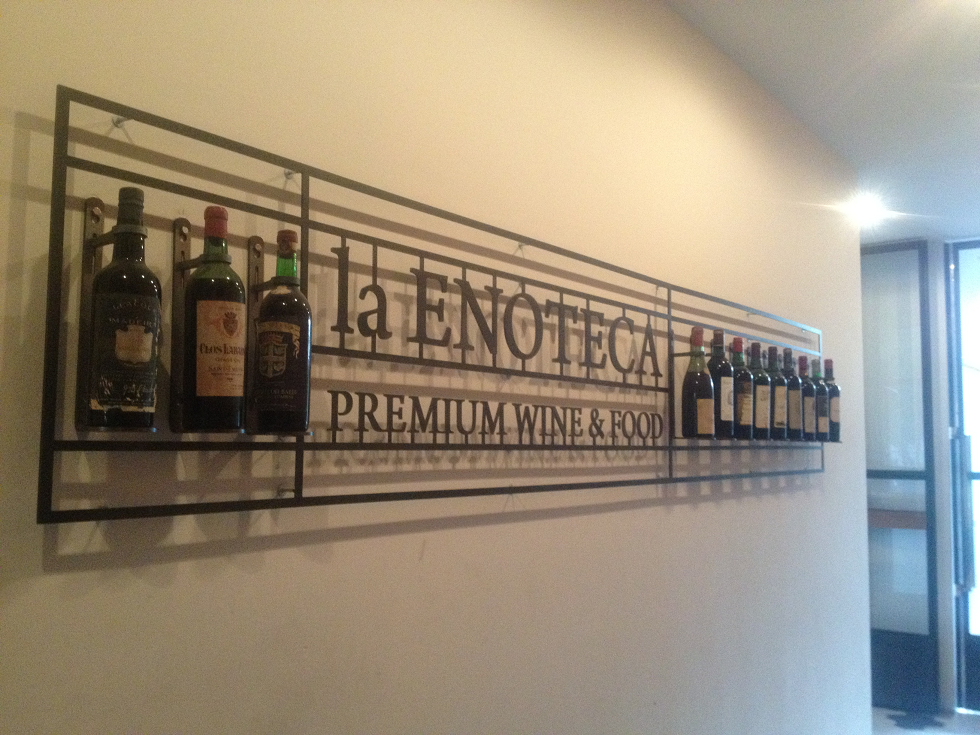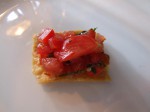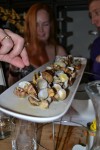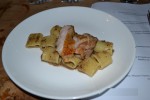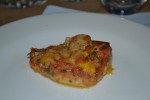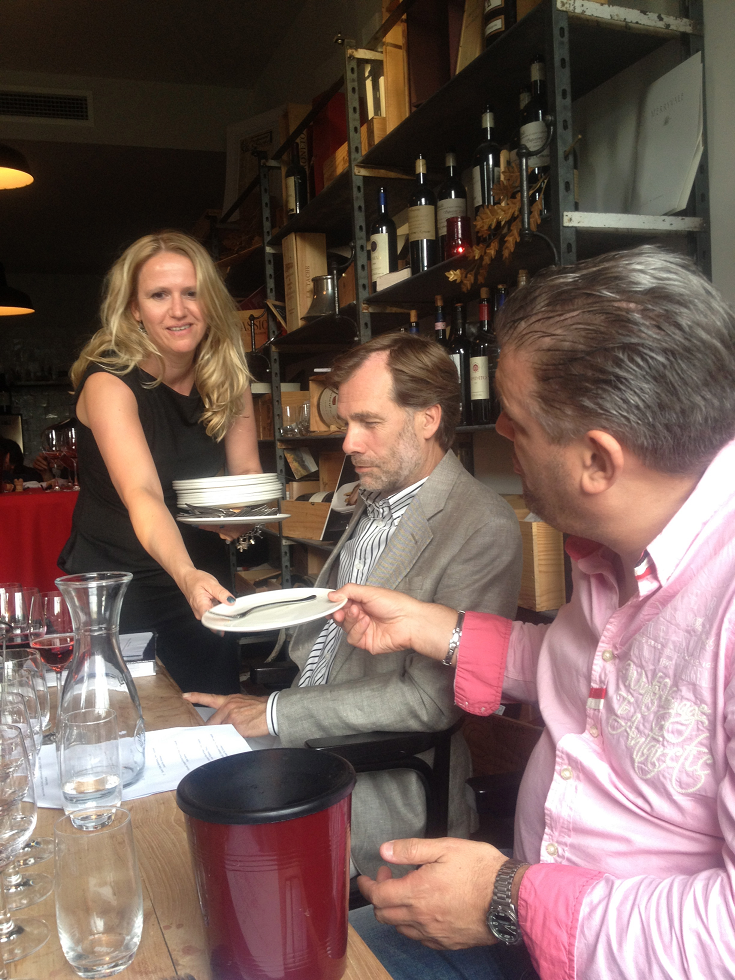De vorige 3 stukken die ik over mousserende wijnen schreef, waren vooral bedoeld om de enorme verschillen tussen mousserende wijnen te benadrukken.
The grand finale …..
The last three pieces I wrote on sparkling wines, were primarily intended to emphasize the differences between them. Some time ago, I organized an evening at La Enoteca in Rotterdam where the diversity could actually be tasted. It is fun to read about it, but to experience the colours and flavours yourself, is of course quite different and a lot more fun. I hope that this article inspires many to do the same.
The evening at la Enoteca made clear that sparkling wines are incomparable, even if they come from the same region. The typicity of the country, a specific terroir, other grape varieties, individual philosophy of winemakers and alternative winemaking methods, provide a variety that is unparalleled. It is wonderful to taste them all and choose your own favourites.
The unique characteristics of each individual sparkling wine, makes it possible for everyone to choose his or her favourites, for different moods, moments, seasons and of course, to enjoy with a huge variety of dishes.
The latter was extensively ’tested’ in La Enoteca, a very pleasant place to enjoy the finest wines and special food without the sometimes inevitable bla bla. The winelist of La Enoteca is impressive and has many ‘collector’s items’ which do not just gather dust, but are there to be enjoyed. At first owner Lou Borrani may seem a cocky, arrogant fanatic from Rotterdam (apologies: Schiedam), but who looks behind this façade, clearly sees a driven, highly experienced, knowledgeable professional, a generous host with it’s heart in the right place and an unparalleled passion for wine and good food. The team of La Enoteca assured the right ambiance, glasses, service and many tasteful dishes that led to some surprising wine & food pairings.
In company of good friends and relatives, we tasted about 30 sparkling wines, most of them in series of three to accentuate their differences in colour, flavour and taste even better. No contest, but an exploration of varieties in character. It soon became clear that there is indeed no such thing as “a sparkling wine”, a Champagne, a Lambrusco or a Franciacorta. Almost without any exceptions, the wines showed the typical expression of their terroir, grapes and the hand of the winemaker who in the end decides what happens with all those influences. Therefore it was not strange, but fun and instructive to taste a sparkling Riesling from Germany as well as a Sparkling Shiraz from Australia.
After several hours of tasting and it was also clear that, although the overall quality was high, there are large differences in appreciation by those who taste the wines. Recently on TV it was shown again that not only consumers, but also experienced professionals rarely agree when tasting wines. My assertion that wine tasting is not an exact science and “points are pointless’, it was confirmed. Also at La Enoteca opinions varied. But, more important, everyone enjoyed the selection and could choose his or her own favourites, often more than one (two, three…). Below, a list of the wines, a brief explanation and my taste experience in words. Perhaps a source of inspiration for others.
Prior to that overview, my thanks to:
– Importers:
Bacchantes, Bubbles by Bruud, August Hoon, Hosman Vins, Karakter Wijnimport, De Microscoop, Moët-Hennessy Netherlands, Residence Wines, Verbunt Wijnkopers, De Vier Heemskinderen, Vinites and Werkhoven Wines
– Producers:
Berlucchi, Casebianche, Castagna, Cleto Chiarli, Andrea Faccio / Villa Giada, Medici Ermete and Raventós i Blanc
– Tot PR
– Nitiya and Daan Jonker for several pictures
And last but not least:
– Everyone at La Enoteca and Lou Borrani in particular
Alksandr Cuvee, Chardonnay, Acorex, Moldova
Chardonnay, Pinot Blanc added. Jean-Mark Sauboua the French winemaker on this domain in Moldova (between Romania and Ukraine) with manufacturing facilities in Corten, Tvardita and Valea Perjei.
Fine mousse, ripe scent, floral tones, dried apple, peach and also some pear, smooth and well-fresh, despite the mature style, some toast in the aftertaste. Very successful for its origin and price.
Van Volxem 1900 Riesling Sekt, Wiltingen, Saarland, Germany
Roman Niewodniczanski is a passionate, driven, almost maniacal producer with a huge respect for nature. His wines are purer than pure and belong to the top in Germany.
Residual sugar: 7, total acidity 6.5, alcohol 11.5%
Beautiful, racy scent, clearly Riesling, aromatic with mineral expression, a lot of flint; in the mouth slim, sleek, beautiful, lively acidity, impressions of brioche, white and yellow fruits, excellent sweet / acid balance and fine length. A great glass of wine, pure, natural and very exciting.
Triple Zero, Jacky Blot, Chenin Blanc, Loire, France
Three times zero; no added sugars for chaptalisation, tirage liqueur or liqueur d’expedition.
A wine from at least 50 year old vines in the appellation Mont Louis. Selected grapes with a minimum potential alcohol of 12%. Soft pressing, fermentation in old oak barrels, made according to the method Ancestrale; transferring the wine from the barrel in the bottle before the first alcoholic fermentation is completed. With the end of the fermentation in the bottle, the wine gets its natural light sparkling character. Disgorgement takes place after approximately 15 months.
Beautiful scent, flawless with accents of brioche, typical Chenin Blanc, white blossom, slim with high acidity and thereby refreshing and uplifting, smoky mineral notes on the finish, intense wine
Crémant d’Alsace, Clement Klur, France
In the 13th century village in the French Alsace Katzenthal lie the vineyards of Clement Klur. Together with his wife Francine, he makes wines since 1999 under his own name in a biodynamic way. Made from Pinot Blanc and Auxerrois who have undergone malolactic fermentation.
Wide, generous, mature with elements of ripe apple and pear compote, sultry with hints of cream, clear sweetness, fully mature, easy and accessible
Premiere Bulle de Limoux Blanquette de Limoux, 2010, France
According to some, the Bulle de Limoux was the first sparkling wine ever made and it is said that Dom Pérignon took the recipe / technique from Limoux to Champagne. History records that wine was invented in 1531 in St. Hilaire, just south of Limoux. Although these facts (like the Big Bang theory, the Mayan calendar, etc.) are regularly challenged, the reality is that the Blanquette de Limoux a classic, historical, good and popular sparkling wine. It is served in top restaurants like the Librije (***) in Zwolle and every year, many Dutch wine & food celebrities show up at the annual auction of wine barrels in Limoux, to try and buy their own personal wine.
Made of 90% Mauzac, 5% and 5% Chardonnay Chenin with lower pressure of 2.5 bar and therefore more friendly character.
Fine mousse, soft and easy flavours and taste, accessible by softer mousse and taste, dry but not aggressive, nice balance between sweetness and acidity, pleasant and affordable.
Valgrès Rive di Combai, Grand Cuvée Extra dry, Serre, Valdobbiandene, Italy
Made from grapes from the best plots of Serre on the Rive di Combai in the heart of the Prosecco DOCG area. The grapes for the Valgrès are on a very steep slope with an ideal exhibition.
Nice clean smell, green apple, pear, blossom, jasmine and a certain terroir influence, smooth taste, yet bold with a nice length and complexity, which maintains a modest character.
Grave di Stecca, Nini Franco Prosecco di Valdobiadene Superiore Brut, 2009, Italy
100% Glera (the historical name of the Prosecco grape), the old vineyard Grave di Stecca, a clos on the slopes of the Prealpi, near the city of Valdobbiadene.
Deep in colour but still lively (almost all other 2009’s are already dead and buried); impressions of dried fruits like apricots and apple, sage is also recognizable in the smell, rich and generous in the glass, lots of juice and flavour, developed but still lively and definitely not tired, Prosecco rich with potential, very special
Premium Vecchia Modena, Cleto Chiarli, Lambrusco di Sorbara, 2011, Italy
This wine has everything a Lambrusco di Sorbara can and should have, a bright pink colour, a charming bouquet with hints of strawberries and raspberries, delicious dry and fresh, pungent flavour with fine lively acidity and perfect balance, a party in the glass. A delicious Lambrusco
Otello, Nero di Lambrusco (Maestri), Ceci, Emilia IGT, Italy
Harvested early October and fermented after soaking of 5-7 days at low temperature. The scent is somewhat restricted, doesn’t give much at first, but the taste is inviting and pure, dry with notes of strawberry and elderberry, good body with ripe tannins for grip and a delicate, well balanced, almost hidden sweetness. Very nice.
Concerto Medici Ermete, Lambrusco Reggiano, 2011, Italy
Intense purple-red, intense smell of black fruits, blackberries, elderberries and black cherries; completely dry taste, very fruity, soft centre, vivid and fresh, some tannin and fine acidity complement the flavour, challenging wine with perfect balance, invites to eat
Grosvenor, Ridgeview Brut, Sussex, 2009, Great Britain
Blend of mainly Pinot Noir and Pinot Meunier, complemented with Chardonnay.
Full colour, straw yellow, intense mousse, fine bubbles, scent with brioche, fresh apples and white fruit, nice and tight in taste with a racy acidity, yet juicy and powerful, very fresh aftertaste, long finish with hint of raisins, almonds and toast, very nice!
Cellarius, Berlucchi, Franciacorta Brut, 2007, Italy
Blend of Chardonnay (70%) and Pinot Noir (30%). More than 30 months on the lees.
Elegant and round in flavour and taste, very soft and almost velvety, juicy with good acidity, ripe but fresh, delicate fruit tones, some nutty accents, apple, pear and freshly baked bread and brioche, subtle sweetness in the final, rich, complex and tasteful wine
Reserve J. Schram, Schramsberg, 2004, Califonia
85% Chardonnay, 15% Pinot Noir and made to age.
Stubborn odour, nor very expressive at first, slowly open up in the glass, fanned out widely and shows many mature aromas ranging from mandarins and zest to nuts and dried fruit, in the aftertaste also red fruit and honey, long intense finale, broad shouldered wine with its own character, a wine for dinner
Philipponnat, Champagne Royale Reserve Brut NV, France
65% Pinot Noir, 30% Chardonnay and 5% Pinot Meunier.
The Pinot Noir grapes are mainly from own vineyards in Ay and Mareuil sur Ay. The Chardonnay and Pinot Meunier from the heart of the Champagne region. Reserve wines: 25-40%, supplemented with younger wine in a “solera” system. Wine undergoes malolactic fermentation. Dosage of 8 g/l, about 3 years on the lees. Tasted from half bottles.
Beautiful scent, wide and aromatic, youthful and unmistakably Champagne, complex, lots of fruits, both dried and fresh, citrus and white fruit, brioche, toast and hints of honey, a lot of juice and flavour, nice acidity and well dosed bitterness in the aftertaste, hint of raspberry reverberates in the final, very clean.
Pol Roger Champagne Blanc de Blancs, 2000, France
Grapes from Grand Cru vineyards of the Cotes des Blancs. Nine years matured before he comes on the market.
Wide and generous in both nose and mouth, fully mature with the soft lush features of the generous 2000, sultry turn with fresh acidity, white nuts, earthy, terroir, white currants and good length, mature character remains
Cuvée Les Echansons, Mailly, Champagne Grand Cru, 1999, France
75% Pinot Noir, 25% Chardonnay from vineyards planted before 1938.
Champagne of small cooperative with only Grand Cru vineyards in 40 different locations in the area Montagne de Reims.
Matured flavours in the nose, dried fruit, nuts, bread, raisins, apricots and orange marmalade, very concentrated, powerful and yet with refinement and excellent balance, intriguing wine that challenges and invites you to smell and taste it, very complex, great!
Elisabetta Abrami, Franciacorta Rosé, Italy
Elisabetta Abrami is a relatively new producer in Franciacorta. Works with many organic and Pinot Nero. This Brut rosé example up to 70% Pinot Nero, supplemented with 30% Chardonnay
Well nevertheless intense fragrance with delicate aromas from Pinot Nero hear fine red fruit, strawberries, grapy, youthful, smooth taste with good stamina, excellent balance, remains fresh and invigorating; very good
Billecart-Salmon Rose, Champagne, France
Blend of Chardonnay, Pinot Meunier and Pinot Noir.
Wide and luxuriant flavour, deep and powerful, seductive by tones of ripe red fruit, complexity by complementary flavours of white nuts, brioche and made a slight spiciness, beautiful dressing, lots of juice and flavour with the right refinement and a subtle bitterness in the long finish, confirming his reputation as one of the finest rosé Champagnes.
Sparkling Genesis, Castagna, Beechworth 2008, Australia
Biologically, two years on the lees.
No a cheap marketing product, but a mature wine with a story and character. Castagna explores and expands his territory, adding unique wines to the world.
Quirky smell, lots of fruit, blackberries, red currants, cherries, clear Shiraz, some sandalwood, thyme and pepper in both smell and taste fine balance between acidity, sweet ripe fruit and soft tannins, challenging and with a strikingly beautiful refinement
Serendipity, La Matta Spumante Integral, Az.Agr. Casebianche, Italy
Serendipity means a “happy accident” or “pleasant surprise”, finding something good or useful without looking for it to be. Made from organically grown, harvested late Fiano grapes in the province of Salerno in Puglia.
After a gentle compression is a part of the must, immediately frozen, and then as the “liquor liqueur” is used instead of sugar, for the second fermentation inside the bottle. The base undergoes complete alcoholic fermentation in steel, followed by a light cold stabilization. Late November (at the earliest) defrosts must be retained and adds it to the base wine. Immediately afterwards the wine is bottled and provides the added musts for a second fermentation in the bottle.
The wine is obviously cloudy, because the remains of the added must has not be removed.
Soft mousse, the nose is fresh, clean and fruity and very youthful, the taste is completely dry with good acidity and flawless fruit, easily digestible with some citrus notes and white fruit, exciting and very natural, surprising wine with its own story and identity.
Sottoriva Frizzante, Malibran, 2011, Italy
Another lovely, this time by 100% Glera / Prosecco. Manually harvested and then made as Prosecco originally was made, ie fermentation in the bottle. The deposit is not removed which the wine slightly turbid, but also completely dry.
Fine mousse, restrained, good odour intensity with aromas of ripe white fruits like pear and apple, white walnut some bread crust, good acidity and a very lively palate, a great buy and another distinguishingly wine; versatile in gastronomy.
Grand Même, Mauzac Nature, Robert & Bernard Plageoles, Gaillac, France
Plageoles is the undisputed leader in Gaillac. His vision, commitment and wines are widely appreciated. The family is close to nature and is certified organic. The wine is made from the Mauzac, a grape that was used by the Romans and both dry, sparkling wines displays as silent white sweet and lovely, a versatile grape so. This sparkling Mauzac is made on an old, traditional way, the method Gaillacoise or method Rural, which has not yet fully fermented wine is bottled and the continuation of the fermentation in the bottle, the wine has a soft sparkling character. There is no sugar added, the wine is naturally quite dry.
Fine, delicate aroma with impressions of dried apple, some nuts and light straw in the mouth pleasantly dry with superb acidity, a soft mousse and perfect balance, the wine has a lot of character, but a very friendly sort, very pure until the long finish. Very interesting In gastronomy, as an aperitif or companion of many dishes and cheeses and even with not too sweet pastry.
Cava Gran Reserva Personel Manuel Raventós, Raventós i Blanc, 1999, Spain
Two bottles of the Vinotheca Raventós i Blanc were granted for this tasting after I tasted them earlier this year. That was during a vertical tasting at The Grand in Amsterdam with several excellent cavas of this exemplary winery. I was deeply impressed by these wines. Made of 25% Xarel · lo (planted in 1954), 10% Chardonnay (1980), 25% Parellada and 40% Macabeu. The year 1999 was relatively cold and dry the grapes and gave a lot of power. Manual harvest, gentle pressing and separate, alcoholic fermentation in stainless steel. Second fermentation in bottle with a maturation of less than 11 years lie. 405 bottles made …..
Alcohol: 12.3% Acidity: 6.8 g / l tartaric, pH: 3.05, total sugar content: 1.5 g / l
What a wine! Strong and intriguing character, that not everyone understood or appreciated. The smell is intense, very strong, wide and extremely complex with many mature notes, dried apricot, brioche, yellow plums, yeast, bread crust, nuts, raisins, straw, honey, saffran and so on. In the mouth it takes possession of your palette and leaves impressions of the elements that already appeared in the smell, but complemented by a beautiful acidity, lots of juice, hints of orange, zest, more dried fruit and a subtle spiciness. Remains as strong as delicate. One of the finest cavas. A privilege to taste the wine again.
Cuvée Annamaria Clementi, Ca’del Bosco, Franciacorta DOCG, 2003, Italy
If you name a wine after your mother, it better be the best you can do. The Annamaria Clementi by Maurizio Zanella is just that ….
As they themselves indicate, there are for this wine no compromises, no concessions. Only the best is good enough. The base consists of perfect grapes, only in the best years suitable for this wine making. 55% Chardonnay, 25% Pinot Blanc and 25% Pinot Noir, selected from 16 different vineyards with plants that are on average almost 40 years old. Low yield of only 5400 kg grapes, good for 2600 liters of wine. After the alcoholic fermentation follows a malolactic in barriques, where the wine total 7 months stay. In May 2004 the tirage liqueur is added and the wine laid to rest in the cellars of Ca’del Bosco. Since the wine has 6.5 years to lie matured. Disgorgement in autumn 2010, 46.000 bottles made.
The nose shows the richness of the 2003 harvest, ripe fruit, lush, broad, almost unctuous, but with the right fraîcheur even remarkably fresh for 2003; many accents of brioche, almonds and honey, besides raisins and apple blossom; in the mouth complex aromas of ripe fruit, a subtle sweetness, full and balanced, less nervous than 2002, more rounded by the warm harvest; ends clean, purifying your mouth with notes of crème brûlée and a delicate spiciness. Great wine for me now, perfectly mature, but with potential for further maturation.
Giulio Ferrari, TRENTODOC, 2001, Italy
First created in 1972, small production of 42,000 bottles, less than 1% of the total annual production. Grapes (100% Chardonnay) from the Maso Pianizza vineyard, located at 500-600 meters altitude. Ripens at least 10 years on his lie. The 2011 is the current year on the market.
Deep golden, straw yellow color, rich, ripe and yet compact odor, does not yet fully; ripe, sweet apples, nuts, tropical fruits, apricot and citrus, candied, mouth-filling, richly structured, powerful with the right balance and finesse, depth and length, with plenty of tension in the aftertaste of dried herbs, good acidity, lots of juiciness and absolute potential
Poire Granit, Cidre Poiré de Poeriers Anciens du Granit Pétillant Naturel , Eric Bordelet, Normandië, France
Well, not a wine in the strict sense of the word, but a wonderful sparkling product made by former sommelier Eric Bordelet. He wanted to make the best cider in the world, and many believe he has succeeded. Biodynamic, extremely low production (5 tons per hectare. Instead of the usual 70 tons), 20 different varieties of apple trees and 14 pear varieties and a manual picking. The fruit dries 3-9 weeks in wooden crates which is then chopped and puree about 30 hours soaked. Manually pressed (with a traditional wooden press) and a fermentation containing 1 up to 4 months. There is no chaptalisation applied and virtually no sulfur used.
The result is an equally intense and subtle cider with taste and character. Complex with a delicate mousse and beautiful pure tones of honey, blossom and (of course) both fresh, dried and caramelised pear. The only 3% alcohol, the wine is easy to digest. Exciting and always a special experience.
Moscato d’Asti, Villa Giada di Andrea Faccio, 2011, Italy
Moscato d’Asti is a wine with a lot of supporters and opponents. The sweet encounters many against the chest or is properly nurtured. Keyword Moscato d’Asti is balance, perhaps more than in any wine whatsoever. Sweet elements must be balanced out by the right acidity. Many Moscato’s are just flat and sweet, a minority has a freshness that invites to drink a second, third, fourth glass. In summer a good Moscato is fun drinking, especially when it is chilled. In other seasons it is delicious with fresh fruit, pastries, and even as an aperitif or just in between. Andrea Faccio is a producer who learned the trade from his father, but by travelling, asking questions, watching and listening to many professional all around the world, he learned how to add an extra dimension to the wines of his family. His speciality is Barbera, but like any domain in the Asti-region, they can not do without a Moscato.
The vinification is aimed to the aromatic expression of the Moscatodruif, so briefly and cooled, followed by a just enough filtration to avoid further fermentation. Already in the spring after the harvest, the wine is marketed. Several bottlings ensure that the wine is always fresh.
Very aromatic, with typical aromas of the Moscato, supplemented with some sage and citrus, a fresh sweet characterizes the taste of the wine is approachable and seductive, perfect balance, decent length. Not the most complex wine, but that is not the intention of the wine.
Dom Perignon Champagne Millisimé, Moët et Chandon, 2003, France
A producer I met recently, called Dom Perignon the best wine in the world. Not purely because of the quality, but also because of the brilliant, ultimate concept. Very high quality, great price and a very exclusive image while the production reaches about 5 million bottles every year. The composition, origin and vinification is unknown. For decades, Rolls Royce was asked the exact amount of horsepower of their engines. The only answer was: “Enough.” Dom Perignon sees himself surrounded by mysteries and lovers devour them. Sometimes it is not necessary to discuss if 12.2 or 12.3% Pinot Something is used … Sometimes it’s just enough to be impressed by the overall product and let emotion prevail over analysis .
We decided to end the official part of the evening with the 2003 Dom Perignon and there was nobody who objected…. The wine showed to be a worthy ending of a magnificent evening and proved why the wine is so successful. The name evokes beautiful associations, seduces, gives people an exclusive feeling and invites to everything except an over-critical or (apparently) objective judgment. Once I heard the slogan: “If Sofia Loren is plastic, I love plastic”. There are those who criticize Dom Perignon, but who tastes the wine and is willing to be enchanted by it’s mystical powers, can only be positive.
The summer of 2003 was hot and many wines clumsy and dull, but this Dom Perignon has more to offer than just ripe fruit. Delicate floral accents in the nose with brioche, candied fruit, some citrus zest and mineral accents, alongside sweet spices and something silty, mild flavour, but with the right tension, nervousness and a subtle bitterness, the wine resonates long after and makes you long for the next and next and next glass ….
For sales information:
Alksandr Cuvee, Chardonnay, Moldova – Vinites, Haarlem
From Volxem 1900 Riesling Sekt, Saarland, Germany – Vinites, Haarlem
Triple Zero, Jacky Blot, Chenin, Loire, France – Vinites, Haarlem
Premiere Bulle de Limoux Blanquette de Limoux, 2010 – Bacchantes, Gouda
Valgrès Rive di Combai, Extra dry, Valdobbiandene, Serre – Bubbles by Bruud, Rotterdam
Nini Franco Prosecco Superiore di Valdobiadene Grave di Stecca – Hosman Vins, Schiedam
Cleto Chiarli, Premium, Vecchia Modena-Vinites, Haarlem
Lambrusco di Sorbara, Italy, 2011-Vinites, Haarlem
Otello, Nero di Lambrusco (Maestri), Ceci, Emilia IGT – De Microscoop, Rotterdam
Concerto Lambrusco Reggiano, Medici Ermete – Goessens, Wine Professionals
Cellarius, Berlucchi, Franciacorta Brut, 2007, Italy – None importer in the Netherlands
Grosvenor, Ridgeview Brut, Sussex, Great Britain, – Karakter Wijnimport, Amsterdam
Schramsberg Reserve J. Schram 2004 – Hosman Vins, Schiedam
Philipponnat, Champagne Royale Reserve Brut NV – Vinites, Haarlem
Pol Roger Champagne Blanc de Blancs, 2000, France – Verbunt Wijnkopers, Tilburg
Mailly, Cuvée Les Echansons, Champagne Grand Cru 1999 – Hosman Vins, Schiedam Elisabetta Abrami Franciacorta Rosé, Italy – Bubbles by Bruud, Rotterdam
Billecart-Salmon Rose, Champagne, France – Residence Wines, Roeofarendsveen
Sparkling Genesis Castagna, Beechworth 2008, Australia – Vinites. Haarlem
Serendipity, La Matta, Spumante Integral, Casebianche – No importer in the Netherlands.
Sottoriva Anti Frizz su Lie, Malibran, – Bubbles by Bruud. Rotterdam
Grand Même, Mauzac Nature, Plageoles, Gaillac, France – August Hoon
Cava Gran Reserva Personel Marcel Raventós, Raventós i Blanc – Vinites, Haarlem
Annamaria Clementi, Ca’del Bosco, Franciacorta Werhoven Wijnen. Nieuwegein
Giulio Ferrari, TRENTODOC – Vinites, Haarlem
Poire Granit, Eric Bordelet – De Vier Heemskinderen, Stavoren
Moscato d’Asti, Villa Giada di Andrea Faccio – JJC Kwast Wijnkopers, New Vennep
Dom Perignon Champagne Millisimé, Moët et Chandon – Moët Hennessy Netherlands, Baarn
Bollinger La Grande Année, 1997
Almost everyone gone, the tables almost empty, the empty bottles collected, followed by a moment of peace and quiet, talking about an amazing evening. Lou Borrani knew somwthing to loosen our tongues. He served a wine, a sparkling wine …. We were asked to guess … I recognized the style of Bollinger and thought of a 2002. It was the 1997, still powerful and persuasive, younger than expected. Broad and rich with lots of dried apple, iodine, some creme brulee and lots of fresh notes of citrus, fresh and preserved; much length, filling and potential. Very beautiful.
Importer: Wijn Verlinden ’s HertogenboschEnige tijd geleden organiseerde ik een avond bij La Enoteca in Rotterdam en was die enorme diversiteit ook daadwerkelijk te proeven. Het is immers leuk om er over te lezen, maar de verschillende kleuren, geuren en smaken zelf zien, ruiken en in je mond ervaren is toch heel wat anders. Ik hoop dan ook dat dit artikel velen inspireert om hetzelfde te doen.
De avond bij la Enoteca maakte duidelijk dat mousserende wijnen, zelfs al komen ze uit één streek, niet of nauwelijks te vergelijken zijn. De typiciteit van het land, de specifieke terroir, andere druivensoorten, wijnmakers met een eigen filosofie en alternatieve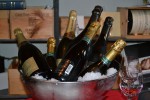 vinificatiemethoden geven een verscheidenheid die zijn weerga niet kent. Het is heerlijk om ze allemaal te proeven en je eigen favorieten te kiezen.
vinificatiemethoden geven een verscheidenheid die zijn weerga niet kent. Het is heerlijk om ze allemaal te proeven en je eigen favorieten te kiezen.
De unieke eigenschappen van elke individuele mousserende wijn maakt dat iedereen wel zijn of haar lievelingswijn vindt. Om diezelfde reden zijn ze ook op allerlei verschillende momenten in te zetten, of dat nu ’s ochtends, ’s middags, ’s avonds of 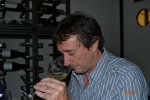 ’s nachts is, in de lente, zomer, herfst of winter, binnen of buiten en als je blij bent of juist verdrietig. Uiteraard zorgt die variatie ook dat er altijd een mousserende wijn past bij alle gerechten die je maar kunt verzinnen.
’s nachts is, in de lente, zomer, herfst of winter, binnen of buiten en als je blij bent of juist verdrietig. Uiteraard zorgt die variatie ook dat er altijd een mousserende wijn past bij alle gerechten die je maar kunt verzinnen.
Dat laatste werd uitgebreid ‘getest’ in la Enoteca, een uiterst aangename plaats om uitgebreid en zonder poespas te genieten van de mooiste wijnen en bijzonder eten. De wijnkaart van la Enoteca is indrukwekkend en telt veel ‘collector’s items’ die hier niet 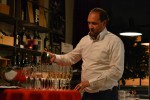 liggen te verstoffen, maar gewoon genoten kunnen worden. Eigenaar Lou Borrani is voor sommigen een eigenwijze, arrogante fanaticus, maar wie door deze Rotterdamse (excuses: Schiedamse) branie heenkijkt, ziet een gedreven, uiterst ervaren, kundige en gastvrije gastheer met het hart op de juiste plaats en een ongekende passie voor wijn en lekker eten.
liggen te verstoffen, maar gewoon genoten kunnen worden. Eigenaar Lou Borrani is voor sommigen een eigenwijze, arrogante fanaticus, maar wie door deze Rotterdamse (excuses: Schiedamse) branie heenkijkt, ziet een gedreven, uiterst ervaren, kundige en gastvrije gastheer met het hart op de juiste plaats en een ongekende passie voor wijn en lekker eten.
De equipe van la Enoteca zorgde die avond dan ook voor de juiste ambiance, de juiste glazen, de juiste service en vele gerechten die enkele zeer verrassende combinaties opleverden.
 In goed gezelschap werden circa 30 mousserende wijnen geproefd, de meeste in series van drie om verschillen in kleur, geur en smaak nog beter tot hun recht te laten komen. Geen wedstrijd, maar juist genieten van een keur aan karakters. Al snel werd duidelijk dat er inderdaad niet zoiets bestaat als: een mousserende wijn, een Champagne, een Lambrusco of een Franciacorta. De wijnen bleken vrijwel zonder uitzondering de typische expressie weer te geven van hun eigen terroir, de druiven waarvan ze gemaakt zijn en de hand van de wijnmaker die uiteindelijk bepaalt wat er met al die invloeden gebeurt. Daarom was het niet vreemd, maar juist leuk en leerzaam zowel een mousserende Riesling uit Duitsland te proeven naast een Sparkling Shiraz uit Australië.
In goed gezelschap werden circa 30 mousserende wijnen geproefd, de meeste in series van drie om verschillen in kleur, geur en smaak nog beter tot hun recht te laten komen. Geen wedstrijd, maar juist genieten van een keur aan karakters. Al snel werd duidelijk dat er inderdaad niet zoiets bestaat als: een mousserende wijn, een Champagne, een Lambrusco of een Franciacorta. De wijnen bleken vrijwel zonder uitzondering de typische expressie weer te geven van hun eigen terroir, de druiven waarvan ze gemaakt zijn en de hand van de wijnmaker die uiteindelijk bepaalt wat er met al die invloeden gebeurt. Daarom was het niet vreemd, maar juist leuk en leerzaam zowel een mousserende Riesling uit Duitsland te proeven naast een Sparkling Shiraz uit Australië.

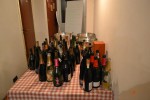
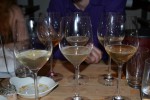
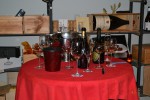
Na enkele uren proeven en genieten werd het ook duidelijk dat, hoewel het algehele kwaliteitsniveau hoog tot zeer hoog was, er grote verschillen zijn in appreciatie door diegene die de wijnen proeft. Onlangs werd op TV nog eens (aan)getoond dat niet alleen consumenten, maar ook ervaren professionals het zelden met elkaar eens zijn. Mijn stelling dat wijnproeven geen exacte wetenschap is en ‘points pointless’ zijn, werd m.i. duidelijk bevestigd. Zo ook tijdens de bewuste avond bij La Enoteca. Meningen varieerden, maar 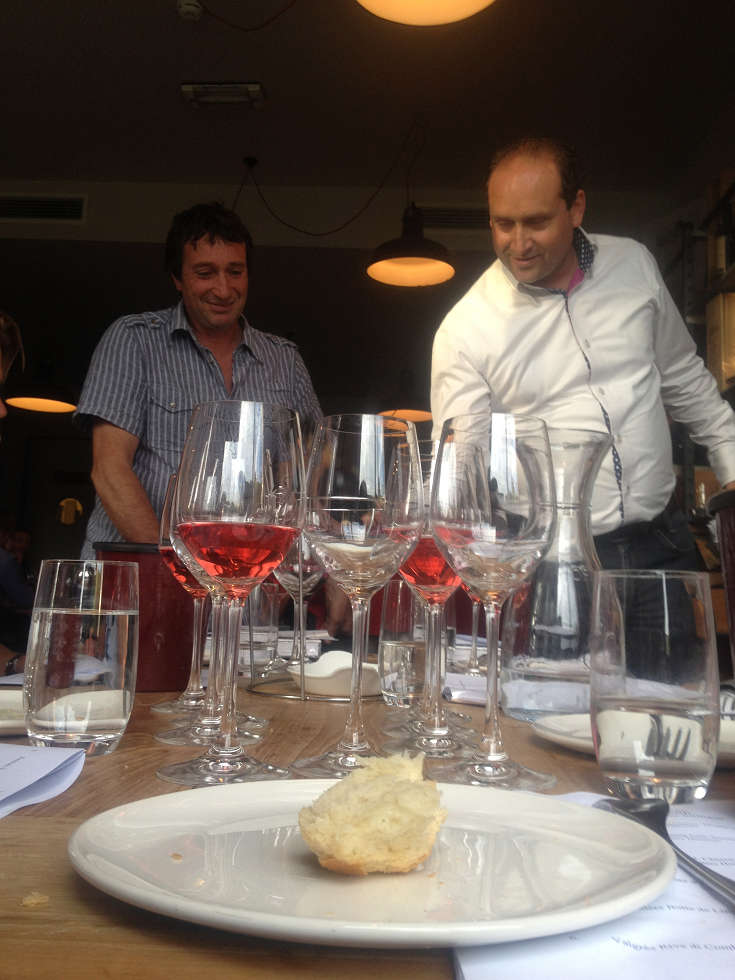 belangrijker was het, dat een ieder genoot en de selectie iedereen in staat stelde zijn of haar eigen favorieten te kiezen. Omdat de keuze groot was, waren dat niet zelden meerdere wijnen. Hieronder een overzicht met de wijnen, een korte toelichting en mijn smaakervaring in woordjes. Wellicht dat het ook andere liefhebbers inspireert om eens wat anders te kiezen.
belangrijker was het, dat een ieder genoot en de selectie iedereen in staat stelde zijn of haar eigen favorieten te kiezen. Omdat de keuze groot was, waren dat niet zelden meerdere wijnen. Hieronder een overzicht met de wijnen, een korte toelichting en mijn smaakervaring in woordjes. Wellicht dat het ook andere liefhebbers inspireert om eens wat anders te kiezen.
Voorafgaand aan dat overzicht, eerst mijn dank aan:
– Importeurs:
Bacchantes, Bubbles by Bruud, August Hoon, Hosman Vins, Karakter Wijnimport, De Microscoop, Moët-Hennesy Nederland, Residence Wijnen, Verbunt Wijnkopers, De Vier Heemskinderen, Vinites en Werkhoven Wijnen
– Producenten:
Berlucchi, Casebianche, Castagna, Cleto Chiarli, Andrea Faccio/Villa Giada, Medici Ermete en Raventós i Blanc
– Tot PR
– Nitiya en ook Daan Jonker voor diverse foto’s
& last but not least:
– Alle mensen bij la Enoteca en Lou Borrani in het bijzonder
Cuvee Alksandr, Chardonnay, Acorex, Moldavië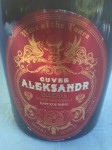
Chardonnay, aangevuld met Pinot Blanc. Jean-Mark Sauboua is de Franse wijnmaker op dit domein in Moldavië (tussen Roemenië en de Oekraïne) met productiefaciliteiten in Corten, Tvardita en Valea Perjei.
Bleekgeel met een fijne mousse, rijpe geur, florale tonen, gedroogde appel, maar ook perzik en wat peer; soepel en goed fris, ondanks de gerijpte stijl, wat toost in de afdronk. Zeer geslaagd voor zijn herkomst en prijs.
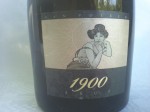 Van Volxem 1900 Riesling Sekt, Wiltingen, Saarland, Duitsland
Van Volxem 1900 Riesling Sekt, Wiltingen, Saarland, Duitsland
Roman Niewodniczanski is een gepassioneerde, gedreven, bijna maniakale producent met een enorm respect voor de natuur. Zijn wijnen zijn puurder dan puur en telt louter toppers.
Restsuiker: 7, zuren totaal 6,5, alcohol 11,5 %
Prachtige, rassige geur, duidelijk Riesling, aromatisch met minerale expressie, veel vuursteen; in de mond slank, strak, met mooie, levendige zuren, impressies van brioche, witte en gele vruchten, uitstekende zoet/zuur balans en prima lengte. Een fantastisch glas wijn, puur, natuurlijk en zeer opwekkend.
Triple Zero, Jacky Blot, Chenin-Blanc, Loire, Frankrijk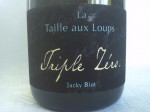
Drie keer nul, d.w.z. geen toegevoegde suikers om te chaptaliseren, geen suiker in de liqueur de tirage en geen suiker in de likeur d’expedition.
Wel een wijn van wijnstokken van tenminste 50 jaar oud in de appellatie Montlouis. Geselecteerde druiven met een minimum alcoholpotentieel van 12%. Zachte persing, gisting in oude eiken vaten, gemaakt volgens de Methode Ancestrale, d.w.z. het overbrengen van de wijn uit vat in de fles voor de eerste alcoholische gisting is voltooid. Met het eindigen van de gisting in de fles, krijgt de wijn zijn natuurlijke licht parelende karakter. Dégorgement vindt plaats na circa 15 maanden.
Fraaie geur, loepzuiver met accenten van brioche, typisch Chenin Blanc, witte bloesem, slank met hoge zuren en daardoor verfrissend en opwekkend, rokerige minerale tonen in de afdronk, intense wijn
Crémant d’Alsace, Clément Klur, Frankrijk
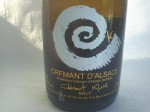 In het 13e eeuwse dorpje Katzenthal in de Franse Alsace liggen de wijngaarden van Clément Klur. Samen met zijn vrouw Francine maakt hij sinds 1999 wijnen onder zijn eigen naam en op biologisch-dynamische wijze. Gemaakt van Pinot Blanc en Auxerrois die de malolactische fermentatie hebben ondergaan.
In het 13e eeuwse dorpje Katzenthal in de Franse Alsace liggen de wijngaarden van Clément Klur. Samen met zijn vrouw Francine maakt hij sinds 1999 wijnen onder zijn eigen naam en op biologisch-dynamische wijze. Gemaakt van Pinot Blanc en Auxerrois die de malolactische fermentatie hebben ondergaan.
Breed geurend naar rijpe appel en perencompote, zwoel met hint van crème, duidelijk zoetje, volledig op dronk, makkelijk en toegankelijk
Première Bulle de Limoux, Blanquette de Limoux, 2010, Frankrijk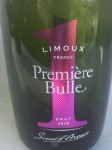
Bulle de Limoux zou de allereerste mousserende wijn ooit gemaakt zijn en Dom Perignon zou het recept/de techniek hebben meegenomen naar de Champagnestreek. De geschiedenis vermeldt dat de wijn al in 1531 werd uitgevonden in St. Hilaire, even ten zuiden van Limoux. Hoewel deze feiten (net als de Big Bang theorie, de Maya-kalender etc.) regelmatig worden betwist, is de realiteit dat de Blanquette de Limoux een eeuwenoude, goede en nog altijd populaire mousserende wijn is. Hij wordt o.a. geschonken in toprestaurants als de Librije in Zwolle en elk jaar zijn veel coryfeeen uit de Nederlandse wijnwereld en gastronomie te zien in Limoux voor de jaarlijkse veiling van vaten wijn, die dan onder de naam van de hoogste bieder gebotteld worden.
Gemaakt van 90% Mauzac, 5% Chenin en 5% Chardonnay met een wat lagere druk ad 2,5 bar en ook daardoor wat vriendelijker van karakter.
Fijne mousse, zacht en soepel qua geur en smaak, laagdrempelig door zachtere mousse en smaak die niet strakdroog maar vrij rond is, goede zoet/zuur balans, aangenaam, ook qua
prijs.
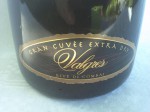 Valgrès Rive di Combai, Grand Cuvée Extra dry, Serre, Valdobbiandene, Italië
Valgrès Rive di Combai, Grand Cuvée Extra dry, Serre, Valdobbiandene, Italië
Gemaakt van de druiven van de beste percelen van Serre op de Rive di Combai in het hart van het DOCG prosecco-gebied. De druiven voor de Valgrès staan op een zeer steile helling met een ideale expositie.
Mooi schoon, geurend naar rinse appel, peer, bloesem, jasmijn en een zekere terroirinvloed, soepel van smaak, maar tegelijkertijd doortastend met een mooie lengte en complexiteit, houdt een wat ingetogen karakter.
Grave di Stecca, Nini Franco, Prosecco di Valdobiadene Superiore Brut, 2009, Italië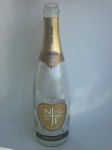
100% Glera (de historische naam van de Prosecco druif), van de oude wijngaard Grave di Stecca, een clos op de hellingen van de Prealpi, vlakbij het stadscentrum van Valdobbiadene.
Vrij veel kleur maar het is dan ook een Prosecco uit 2009 en vrijwel alle andere uit 2009 zijn al dood en begraven….; geurt ingetogen, maar onmiskenbaar zijn de impressies van gedroogd fruit als abrikozen en appel, ook salie is te herkennen in de geur, waaiert breed uit in het glas, veel sap en smaak, ontwikkeld, maar nog altijd levendig en absoluut niet vermoeid, rijke Prosecco met potentieel, heel bijzonder
Premium, Vecchia Modena, Cleto Chiarli, Lambrusco di Sorbara, 2011, Italië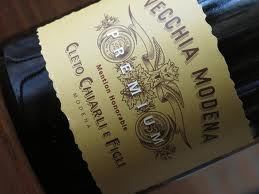
Deze wijn heeft alles wat een Lambrusco di Sorbara kan en moet hebben; een frisse roze kleur, een stuivend bouquet met tonen van aardbeitjes en frambozen; heerlijk droog, fris en stuivend; doordringend van smaak met fijne levendige zuren en een perfecte balans, drinkt heerlijk door en is een feestje in het glas. Wat kan Lambrusco toch mooi en lekker zijn!
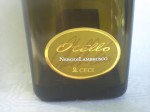 Otello, Nero di Lambrusco (Maestri), Ceci, Emilia IGT, Italië
Otello, Nero di Lambrusco (Maestri), Ceci, Emilia IGT, Italië
Geoogst begin oktober en vergist na een weking van 5 tot 7 dagen op lage temperatuur. De geur is terughoudend, geeft zich niet helemaal, maar is toch uitnodigend en zuiver; qua smaak mooi droog met veel tonen van aardbeien en vlierbes, lekker onstuimig van smaak met goed rijpe tannine voor houvast en een klein ingepakt zoetje. Erg netjes.
Concerto, Medici Ermete, Lambrusco Reggiano, 2011, Italië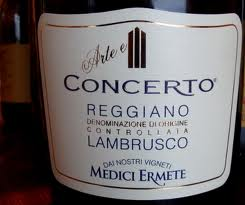
Intens paarsrood, indringende, stuivende geur van zwart fruit, bramen, vlierbessen en zwarte kersen; geheel droog van smaak, zeer fruitrijk, zacht middenrif, levendig en fris, wat tannine en fraaie zuren completeren de smaak, uitdagende wijn met perfecte balans, nodigt uit om te eten
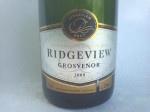 Grosvenor, Ridgeview Brut, Sussex, 2009, Groot-Brittanië
Grosvenor, Ridgeview Brut, Sussex, 2009, Groot-Brittanië
Blend van voornamelijk Pinot Noir en Pinot Meunier, aangevuld met Chardonnay.
Volle kleur, strogeel, intense mousse, fijne belletjes, geur met veel brioche, rinse appel en wit fruit, aangenaam strak in geur en smaak; mooie vulling en rassige zuren, sappig en krachtig, mooi droog, veel fraîcheur, lange afdronk met noten, hint van rozijnen en toost; erg fraai!
Cellarius, Berlucchi, Franciacorta Brut, 2007, Italië
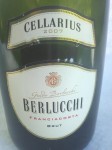 Blend van Chardonnay (70%) en Pinot Noir (30%). Ruim 30 maanden op de lie.
Blend van Chardonnay (70%) en Pinot Noir (30%). Ruim 30 maanden op de lie.
Elegant en afgerond in geur en smaak, heel zacht en bijna fluwelig, sappig met mooie zuren, gerijpt maar fris, fijne fruittonen, wat nootachtige accenten, appel, peer en versgebakken brood en brioche, subtiel zoetje in de finale; rijke, complexe wijn met veel smaak
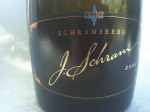 Reserve J. Schram, Schramsberg, 2004, Califonië
Reserve J. Schram, Schramsberg, 2004, Califonië
85% Chardonnay, 15% Pinot Noir en gemaakt om te ouderen.
Eigenwijze geur, geeft zich in eerste instantie niet of nauwelijks, komt dan langzaam op gang in het glas, waaiert breed uit en toont allerlei gerijpte aroma’s variërend van mandarijnen en zest tot noten en gedroogd fruit, in de afdronk ook rood fruit en honing; lange intense finale, breed geschouderde wijn met eigen karakter, serieuze eetwijn
Philipponnat, Champagne Royale Réserve Brut, NV, Frankrijk 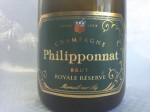
Van 65% Pinot Noir, 30% Chardonnay en 5% Pinot Meunier.
De Pinot Noir druiven zijn hoofdzakelijk afkomstig uit eigen wijngaarden in Ay en Mareuil sur Ay. De Chardonnay en Pinot Meunier uit het hart van de Champagne-streek. Reserve wijnen: 25 tot 40%, aangevuld met jongere wijn in een “solera” systeem. Wijn ondergaat malolactische gisting. Dosage van 8 g/l, ongeveer 3 jaar op de lie. Geproefd uit halve flesjes.
Fraaie geur, breed en aromatisch, jeugdig en onmiskenbaar Champagne, complex, veel fruit, zowel gedroogd als vers, citrus en wit fruit, brioche, toost en hint van honing, veel sap en smaak, fraaie zuren en mooi gedoseerd bittertje in de afdronk, hint van framboos galmt na in de finale, erg netjes.
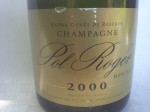 Pol Roger, Champagne Blanc de Blancs, 2000, Frankrijk
Pol Roger, Champagne Blanc de Blancs, 2000, Frankrijk
Druiven afkomstig van Grand Cru wijngaarden in de Cotes des Blancs. Negen jaar gerijpt voor hij op de markt komt.
Breed en zalvend in zowel geur als smaak, volledig uitgerijpt en met de zachte weelderige kenmerken van het gulle jaar 2000, zwoele aanzet met frisse zuren, blanke noten, aardse tonen, terroir, witte bessen en goede lengte, uitgerijpte karakter blijft van begin tot einde overheersen.
Cuvée Les Echansons, Mailly, Champagne Grand Cru, 1999, Frankrijk 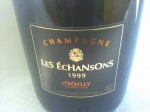
75% Pinot Noir, 25% Chardonnay van wijngaarden die voor 1938 zijn aangeplant.
Champagne van kleine coöperatie met uitsluitend Grand Cru wijngaarden op 40 verschillende locaties in het gebied Montagne de Reims.
Gerijpte geur, neigt naar belegen, gedroogde vruchten, noten, brood, rozijnen, abrikozen en sinaasappelmarmelade, heel geconcentreerd, krachtig en toch met verfijning en uitstekende balans, intrigerende wijn die je blijft uitdagen en uitnodigen om te ruiken en te proeven, zeer complex en heel veel lengte ; groots!
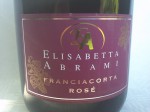 Elisabetta Abrami, Franciacorta Rosé, Italië
Elisabetta Abrami, Franciacorta Rosé, Italië
Elisabetta Abrami is een relatief nieuwe producent in Franciacorta. Werkt biologisch en met veel Pinot Nero. Deze Brut rosé bijvoorbeeld maar liefst 70% Pinot Nero, aangevuld met 30% Chardonnay
Goed intense geur met desalniettemin delicate aroma’s die bij Pinot Nero horen, fijn rood fruit, aardbeitjes, druivig, jeugdig, soepel van smaak met goed doorzettingsvermogen, excellente balans, blijft mooi fris en opwekkend; zeer goed
Billecart-Salmon Rosé, Champagne, Frankrijk 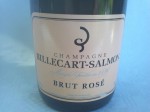
Blend van Chardonnay, Pinot Meunier en Pinot Noir.
Breed en weelderig van smaak, diep en krachtig, verleidelijk door tonen van rijpe rode vruchten, complexiteit door aanvullende geuren en smaken van blanke noten, brioche en zelf een lichte kruidigheid, prachtige vulling, veel sap en smaak met de juiste verfijning en een subtiel bittertje in de lange afdronk, bevestigt zijn reputatie als één van de allerbeste rosé Champagnes.
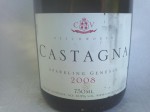 Sparkling Genesis, Castagna, Beechworth, 2008, Australië
Sparkling Genesis, Castagna, Beechworth, 2008, Australië
Biologisch, twee jaar op de lie.
Geen goedkoop marketingproduct, maar een volwassen wijn met een verhaal en overtuiging. Castagna verkent grenzen, verlegt ze en voegt met deze wijn een uniek product toe aan de wijnwereld.
Eigenzinnige geur, veel fruit, bramen, rode bessen, kersen, duidelijk Shiraz ; ook wat sandelhout, tijm en peper, in zowel geur als smaak ; fijne balans tussen zuren, zoet rijp fruit en zachte tannine, uitdagend en met een opvallend mooie verfijning
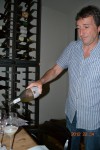 Serendipity, La Matta Spumante Integrale, Az.Agr. Casebianche, Italië
Serendipity, La Matta Spumante Integrale, Az.Agr. Casebianche, Italië
Serendipity betekent een ‘gelukkig toeval “of” aangename verrassing “, het vinden van iets goeds of nuttigs, zonder er naar op zoek te zijn. Gemaakt van biologisch geteelde, laat geoogste Fiano druiven in de provincie Salerno in Puglia.
Na een zachte persing is een deel van de most onmiddellijk ingevroren en vervolgens als “likeur de tirage” gebruikt in plaats van suiker, voor de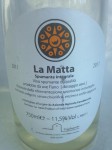 tweede vergisting in de fles. De basis ondergaat de volledige alcoholische gisting in staal, gevolgd door een lichte koude stabilisatie. Eind november (op z’n vroegst) ontdooit men de bewaarde most en voegt deze aan de basiswijn toe. Direct daarna wordt de wijn gebotteld en zorgt de toegevoegde most voor een tweede gisting op fles.
tweede vergisting in de fles. De basis ondergaat de volledige alcoholische gisting in staal, gevolgd door een lichte koude stabilisatie. Eind november (op z’n vroegst) ontdooit men de bewaarde most en voegt deze aan de basiswijn toe. Direct daarna wordt de wijn gebotteld en zorgt de toegevoegde most voor een tweede gisting op fles.
De wijn is uiteraard wat troebel, omdat de restanten van de toegevoegde most niet worden verwijderd.
Zachte mousse ; de neus is fris, zuiver en fruitrijk, heel jeugdig en wat onstuimig ; de smaak volledig droog met mooie zuren en loepzuiver fruit, licht verteerbaar met wat citrustonen en wit fruit, opwekkend en heel natuurlijk, verrassende wijn met een eigen verhaal en identiteit.
 Sottoriva Frizzanti su Lie, Malibràn, 2011, Italië
Sottoriva Frizzanti su Lie, Malibràn, 2011, Italië
Nog zo’n heerlijk eigenwijze wijn, dit keer van 100% Glera/Prosecco. Handmatig geoogst en daarna gemaakt zoals Prosecco van origine werd gemaakt, d.w.z. met gisting op de fles. Het depot wordt niet verwijderd hetgeen de wijn iets troebel maakt, maar ook volledig droog.
Fijne mousse, ingetogen; goede geurintensiteit met aroma’s van rijp, wit fruit als peer en appel, blanke noten wat broodkorst, goede zuren en een heel levendig smaakpalet, zeer koopwaardig en wederom een wijn waarmee je je kunt onderscheiden. Breed inzetbaar in de gastronomie.
Grand Même, Mauzac Nature, Robert & Bernard Plageoles, Gaillac, Frankrijk 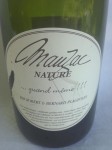
Plageoles is de onbetwiste leider in Gaillac. Zijn visie, inzet en wijnen worden breed gewaardeerd. De familie staat dicht bij de natuur en werkt gecertificeerd biologisch. De wijn wordt gemaakt van de Mauzac, een druif die al door de Romeinen werd gebruikt en zowel droge, mousserende wijnen geeft als stille witte en prachtige zoete; een veelzijdige druif dus. Deze mousserende Mauzac wordt gemaakt op een oude, klassieke wijze, de Méthode Gaillacoise cq Méthode Rurale, waarbij de nog niet geheel uitgegiste wijn gebotteld wordt en de voortzetting van de gisting op fles, de wijn een zacht mousserend karakter geeft. Er wordt dus geen suiker toegevoegd; de wijn is van nature geheel droog.
Fijne, delicate geur met impressies van gedroogde appel, wat noten en licht stro, in de mond aangenaam droog met prachtige zuren, een zachte mousse en perfecte balans; de wijn heeft veel karakter, maar dan wel een heel vriendelijk soort; zeer zuiver tot in de lange afdronk. Heel interessant om in de gastronomie in te zetten als aperitief of begeleider van allerlei gerechten en kazen tot aan niet te zoete patisserie toe.
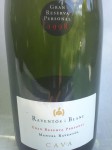 Cava Gran Reserva Personel Manuel Raventós, Raventós i Blanc, 1999, Spanje
Cava Gran Reserva Personel Manuel Raventós, Raventós i Blanc, 1999, Spanje
Twee flessen uit de oenotheek van Raventós i Blanc werden speciaal voor deze proeverij opgestuurd na een kennismaking eerder dit jaar. Dat was tijdens een verticale proeverij met de uitmuntende cava’s van dit voorbeeldige wijnhuis bij The Grand in Amsterdam. Ik was toen diep onder de indruk van deze wijn. Gemaakt van 25% Xarel·lo (aangeplant in 1954,), 10% Chardonnay (1980), 25% Parellada en 40% Macabeu. Het jaar 1999 was relatief koud en droog en gaf de druiven veel kracht. Handmatige oogst, zachte persing en separate, alcoholische gisting in RVS. Tweede gisting op fles met een rijping van maar liefst 11 jaar op lie. 405 flessen gemaakt…..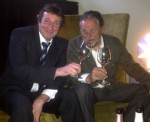
Alcohol: 12,3%, Acidity: 6,8 g/l tartaric, pH: 3,05, total sugar content: 1,5 g/l
Een plaatje van een wijn, maar met een zo eigen, indringend karakter, dat niet iedereen hem begreep of waardeerde. De geur is intens, zeer krachtig, breed en uiterst complex met veel gerijpte tonen, gedroogde abrikoos, brioche, gele pruimen, gist, broodkorst, noten, rozijnen, stro, honing, saffraan en ga zo maar door; in de mond waaiert de wijn breed uit, neemt bezit van je palet en geeft zich volledig; geurimpressies komen terug, aangevuld met schitterende zuren, veel sap, tonen van sinaasappel, zest, nog meer gedroogd fruit en een subtiele kruidigheid. Blijft even krachtig als delicaat. Eén van de allermooiste cava’s en een voorrecht om de wijn wederom te mogen proeven.
 Cuvée Annamaria Clementi, Ca’del Bosco, Franciacorta DOCG, 2003, Italië
Cuvée Annamaria Clementi, Ca’del Bosco, Franciacorta DOCG, 2003, Italië
Als je een wijn de naam van je moeder geeft, dan moet hij gewoon het beste zijn wat je kunt maken. De Annamaria Clementi van Maurizio Zanella is dat….
Zoals men zelf aangeeft, gelden er voor deze wijn geen compromissen, geen concessies. Alleen het beste is goed genoeg. De basis bestaat uit perfecte druiven, alleen in de allerbeste jaren geschikt om deze wijn te maken. 55% Chardonnay, 25% Pinot Blanc en 25% Pinot Noir, geselecteerd uit 16 verschillende wijngaarden met planten die gemiddeld bijna 40 jaar oud zijn. Lage opbrengst van slechts 5400 kg druiven, goed voor 2600 liter wijn. Na de alcoholische gisting volgt een malolactische in barriques, waarin de wijn totaal 7 maanden verblijft. In mei 2004 is de liqueur de tirage toegevoegd en de wijn te rusten gelegd in de kelders van Ca’del Bosco. Daar heeft de wijn 6,5 jaar op lie gerijpt. Dégorgement in najaar van 2010, 46.000 flessen gemaakt.
In de neus is de rijkdom van het oogstjaar 2003 te ruiken, veel rijp fruit, weelderig, breed, bijna zalvend, maar met de juiste fraîcheur, zelfs opvallend fris voor 2003; veel accenten van brioche, amandelen en honing, naast rozijnen en appelbloesem; ook in de mond complexe aroma’s, veel rijp fruit, een subtiel zoetje, vol en evenwichtig, minder nerveus dan 2002, meer afgerond door het warme oogstjaar; eindigt schoon en mondzuiverend met tonen van crème brûlée en een fijne kruidigheid. Grootse wijn, wat mij betreft nu perfect op dronk, maar met potentieel voor verdere rijping.
Giulio Ferrari, TrentoDoc, 2001, Italië
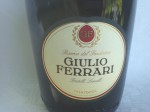 Voor het eerst gemaakt in 1972, kleine productie van 42.000 flessen, minder dan 1% van de totale jaarlijkse productie. Druiven (100% Chardonnay) afkomstig van de Maso Pianizza wijngaard, gelegen op 500-600 meter hoogte. Rijpt minstens 10 jaar op zijn lie. De 2011 is het actuele jaar op de markt.
Voor het eerst gemaakt in 1972, kleine productie van 42.000 flessen, minder dan 1% van de totale jaarlijkse productie. Druiven (100% Chardonnay) afkomstig van de Maso Pianizza wijngaard, gelegen op 500-600 meter hoogte. Rijpt minstens 10 jaar op zijn lie. De 2011 is het actuele jaar op de markt.
Diepe gouden, strogele kleur; rijke, gerijpte en toch compacte geur, geeft zich nog niet helemaal; rijpe, zoete appel, noten, tropische vruchten, abrikoos en citrus, gekonfijt, mondvullend, rijk gestructureerd, krachtig met de juiste balans en finesse, diepgang en lengte, volop spanning met in de afdronk gedroogde kruiden, mooie zuren, veel sappigheid en absoluut potentieel
 Poiré Granit, Cidre Poiré de Poeriers Anciens du Granit Pétillant Naturel , Eric Bordelet, Normandië, Frankrijk
Poiré Granit, Cidre Poiré de Poeriers Anciens du Granit Pétillant Naturel , Eric Bordelet, Normandië, Frankrijk
Tja, geen wijn in de strikte zijn van het woord, maar wel een prachtig mousserend product deze cider van voormalig sommelier Eric Bordelet. Hij wilde de mooiste cider ter wereld maken, en volgens velen is hij daarin geslaagd. Biodynamisch, extreem lage productie (5 ton per ha. i.p.v. de gebruikelijke 70 ton), 20 verschillende rassen appelbomen en 14 perenrassen en een handmatige pluk. Het fruit droogt 3 tot 9 weken in houten kistjes waarna het wordt fijngesneden en de moes circa 30 uur weekt. Handmatig geperst (met een traditionele houten pers) en een gisting die 1 tot wel 4 maanden duurt. Er wordt geen chaptalisatie toegepast en vrijwel geen zwavel gebruikt.
Het resultaat is een even intense als subtiele cider met veel smaak en karakter. Complex met een delicate mousse en prachtige zuivere tonen van honing, bloesem en (uiteraard) zowel verse, gedroogde als gekaramelliseerde peer. De slechts 3% alcohol houdt de wijn licht verteerbaar. Opwekkend en altijd weer een bijzondere belevenis.
Moscato d’Asti, Villa Giada di Andrea Faccio, 2011, Italië 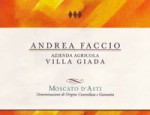
Moscato d’Asti is een wijn met veel voor- en tegenstanders. Het zoete stuit velen tegen de borst of wordt juist gekoesterd. Sleutelwoord in Moscato d’Asti is balans, misschien wel meer dan in welke wijn dan ook. Het vele zoet moet immers gecompenseerd worden door de juiste hoeveelheid zuren. Veel Moscato’s zijn plat en zoet, een minderheid heeft een frisheid die uitnodigt tot het drinken van een tweede, derde, vierde glas. In de zomer is een goede Moscato fantastisch, zeker als hij goed gekoeld is. In andere seizoenen heerlijk bij vers fruit, patisserie en zelfs als aperitief of zomaar tussendoor. Andrea Faccio is een producent die het vak leerde van zijn vader, maar door reizen, vragen, kijken en luisteren veel heeft geleerd en een extra dimensie aan de wijnen van het familiedomein heeft kunnen toevoegen. Zijn specialiteit is Barbera, maar een domein in de regio Asti kan niet zonder Moscato, dus ook de familie Faccio niet.
De vinificatie is gericht op het benadrukken van de aromatische expressie van de Moscatodruif, dus kort en gekoeld, gevolgd door een korte filtratie om de gistcellen te verwijderen. Al in het voorjaar na de oogst wordt de wijn op de markt gebracht. Meerdere bottelingen zorgen dat de wijn altijd vers is.
Heel aromatisch, met de typische geuren van de Moscato, aangevuld met wat salie en ook citrus; een fris zoet kenmerkt de smaak; de wijn is laagdrempelig en verleidelijk, perfecte balans, nette lengte. Niet de meest complexe wijn, maar dat is ook niet de bedoeling van deze wijn.
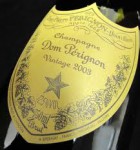 Dom Pérignon, Champagne Millisimé, Moët et Chandon, 2003, Frankrijk
Dom Pérignon, Champagne Millisimé, Moët et Chandon, 2003, Frankrijk
Onlangs noemde een producent Dom Pérignon de beste wijn ter wereld. Niet puur vanwege de kwaliteit, maar door het briljante, ultieme concept. Zeer hoge kwaliteit, een prachtige verkoopprijs, een uiterst exclusief imago en dat terwijl de productie, naar verluidt, 5 miljoen flessen bedraagt.
Over de samenstelling, de herkomst en de vinificatie is weinig bekend. Aan Rolls Royce wordt al decennia gevraagd wat de precieze hoeveelheid pk’s van hun motoren is. Hun antwoord is steevast: “Genoeg”. Dom Pérignon ziet zichzelf ook omhuld door mysteries en liefhebbers smullen ervan. En soms is het niet nodig om eindeloos te discussiëren over het feit of er nu 12,2 of 12,3% Pinot Weetikveel gebruikt is… Soms is het gewoon genoeg om onder de indruk van het totaalproduct te zijn en emotie te laten prevaleren boven analyse.
We besloten het officiële deel van de avond met de 2003 Dom Pérignon en er was niemand die daar enig bezwaar tegen had. De wijn toonde zich een waardig afsluiter van een indrukwekkende avond en bewees waarom de wijn zo’n succes is. De naam roept mooie associaties op, verleidt, geeft een elitair gevoel en nodigt tot alles uit behalve een over-kritisch of (ogenschijnlijk) objectief oordeel. Ooit hoorde ik de slogan: “Als Sofia Loren van plastic is, hou ik van plastic”. Er zijn er die Dom Pérignon bekritiseren, maar wie de wijn proeft en zijn mystieke krachten ervaart, kan eigenlijk alleen maar positief zijn.
De zomer van 2003 was heet en heeft veel wijnen lomp en dof gemaakt, maar in deze Dom Pérignon is alleen maar het rijpe fruit van 2003 te ruiken en te proeven.
Delicate florale accenten in de neus met brioche, gekonfijt fruit, wat citrusschil en minerale accenten, naast zoete specerijen en iets zilts; mild van smaak, maar met de juiste spanning en een subtiel bittertje; de wijn galmt lang na en doet verlangen naar een volgend en volgend en volgend glas….
Voor verkoopinformatie:
Cuvee Alksandr, Chardonnay, Moldavië – Vinites, Haarlem
Van Volxem 1900 Riesling Sekt, Saarland, Duitsland – Vinites, Haarlem
Triple Zero, Jacky Blot, Chenin, Loire, Frankrijk – Vinites, Haarlem
Clement Klur – Tamis Wijnen – Vino Via wijnimport
Premiere Bulle de Limoux, Blanquette de Limoux, 2010 – Bacchantes, Gouda
Valgrès Rive di Combai, Extra dry, Valdobbiandene, Serre – Bubbles by Bruud, Rotterdam
Nini Franco Prosecco di Valdobiadene Superiore Grave di Stecca – Hosman Vins, Schiedam
Cleto Chiarli, Premium, Vecchia Modena -Vinites, Haarlem
Lambrusco di Sorbara, Italie, 2011 -Vinites, Haarlem
Otello, Nero di Lambrusco (Maestri), Ceci, Emilia IGT – De Microscoop, Rotterdam
Concerto, Lambrusco Reggiano, Medici Ermete – Goessens, Professionals in Wijn
Cellarius, Berlucchi, Franciacorta Brut, 2007, Italië – Geen importeur in Nederland
Grosvenor, Ridgeview Brut, Sussex, Groot-Brittanie, – Karakter Wijnimport, Amsterdam
Schramsberg Reserve J. Schram 2004 – Hosman Vins, Schiedam
Philipponnat, Champagne Royale Réserve Brut, NV – Vinites, Haarlem
Pol Roger, Champagne Blanc de Blancs, 2000, Frankrijk – Verbunt Wijnkopers, Tilburg
Mailly, Cuvee Les Echansons, Champagne Grand Cru 1999 – Hosman Vins, Schiedam Elisabetta Abrami Franciacorta Rosé, Italie – Bubbels by Bruud, Rotterdam
Billecart-Salmon Rose, Champagne, Frankrijk – Residence Wijnen, Roeofarendsveen
Sparkling Genesis Castagna, Beechworth, 2008, Australie – Vinites. Haarlem
Serendipity, La Matta, Spumante Integrale, Casebianche – Geen importeur in Nederland.
Sottoriva Frizzanti su Lie, Malibràn, – Bubbles by Bruud. Rotterdam
Grand Même, Mauzac Nature, Plageoles, Gaillac, Frankrijk – August Hoon
Cava Gran Reserva Personel Marcel Raventós, Raventós i Blanc, – Vinites, Haarlem
Annamaria Clementi, Ca’del Bosco, Franciacorta Werhoven Wijnen. Nieuwegein
Giulio Ferrari, TrentoDoc – Vinites, Haarlem
Poiré Granit, Eric Bordelet – De Vier Heemskinderen, Stavoren
Moscato d’Asti, Villa Giada di Andrea Faccio – J.J.C. Kwast Wijnkopers, Nieuw-Vennep
Dom Pérignon, Champagne Millisimé, Moët et Chandon – Moët Hennesy Nederland, Baarn
Bollinger, La Grande Année, 1997
Bijna iedereen weg, de tafels bijna leeg, de flessen verzameld en dan nog even napraten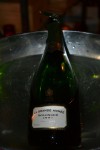 over een geweldige avond. Lou Borrani wist wel wat om het praten iets soepeler te laten verlopen. Hij serveerde een wijn, een mousserende wijn…. We mochten raden… Ik herkende de stijl van Bollinger en dacht aan een 2002. Het bleek de 1997, nog altijd krachtig en overtuigend, jonger dan verwacht. Breed en rijk met veel gedroogde appel, jodium, wat crème brûlée en veel frisse tonen van citrus, vers en gekonfijt; veel lengte, vulling en potentieel. Zeer fraai.
over een geweldige avond. Lou Borrani wist wel wat om het praten iets soepeler te laten verlopen. Hij serveerde een wijn, een mousserende wijn…. We mochten raden… Ik herkende de stijl van Bollinger en dacht aan een 2002. Het bleek de 1997, nog altijd krachtig en overtuigend, jonger dan verwacht. Breed en rijk met veel gedroogde appel, jodium, wat crème brûlée en veel frisse tonen van citrus, vers en gekonfijt; veel lengte, vulling en potentieel. Zeer fraai.
Importeur: Wijn Verlinden ‘s Hertogenbosch
